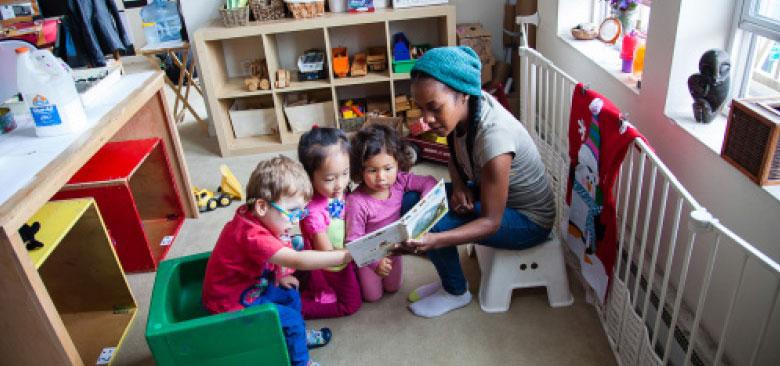
Reducing Pesticide Use in Family Child Care Homes
Chronic exposure to indoor pesticides has been linked to serious health problems in young children, including leukemia, lymphoma, and neurodevelopmental and behavioral problems. Sometimes that exposure occurs in child care facilities. While early care and education (ECE) centers are subject to state laws governing pesticide use, there are fewer regulations for smaller family child care homes (FCCHs), and providers there can be unaware of the pesticides in common household products.
In response, the UC San Francisco School of Nursing’s community-based California Childcare Health Program (CCHP) has used funding from the California Department of Pesticide Regulation (DPR) to develop an integrated pest management (IPM) toolkit and program aimed at helping FCCH providers reduce the exposure of harmful pesticides for children attending family child care homes. A pilot intervention achieved improved use of pesticides, reductions in the number of pests and increased awareness among the FCCH providers about best practices for integrated pest management.
“[FCCHs] have no regulatory reason to comply, but child care providers are interested in learning about IPM to support a healthy environment for their children,” says Professor Abbey Alkon of the Department of Family Health Care Nursing, who led the IPM project for the CCHP.
Addressing a Regulatory Gap in Pesticide Laws
According to 2014 data, more than 312,000 California children receive care from 30,701 licensed FCCHs. These settings offer some families benefits over larger ECE centers, including a homelike environment, greater scheduling flexibility and, often, lower fees. Unlike ECE centers, however, FCCHs aren’t covered by the California Healthy Schools Act, which requires schools and centers to disclose how and when they use pesticides. The law also encourages the voluntary adoption of integrated pest management, which emphasizes long-term prevention of pests through multiple low-risk techniques.
Aware of the gap and that changing the pest management practices of FCCH providers has the potential to affect so many of the state’s youngest children, the DPR provided funding for CCHP staff to modify an IPM toolkit they developed for ECE centers in 2011. The funding also allowed CCHP staff to evaluate the changes in FCCHs’ IPM policies and practices after a six-month intervention by nurse child care health consultants.
 Abbey Alkon “We know that young children are the most vulnerable to pesticides because their organs are still developing, and that’s why we wanted to work with family child care providers. Most of them serve infants and toddlers, while child care centers tend to have mostly preschool-age children,” says Alkon.
Abbey Alkon “We know that young children are the most vulnerable to pesticides because their organs are still developing, and that’s why we wanted to work with family child care providers. Most of them serve infants and toddlers, while child care centers tend to have mostly preschool-age children,” says Alkon.
Alkon’s team also knew that because FCCH providers aren’t required to receive the same IPM education on pesticides as ECE center providers, they might not be aware of the risks from even the most common products used in many households. The project’s initial investigations bore this out. While many providers responded on preintervention surveys that they didn’t use pesticides in their homes, trained nurse-consultants often found containers of pesticides during initial FCCH assessments.
This may be because many people associate the word “pesticide” with commercial products used in agriculture, but they don’t think about the sprays, cleansers and foggers sold in many hardware and home stores for indoor use.
Adapting a Toolkit for Family Child Care Homes
As noted above, the project builds on an earlier CCHP IPM toolkit project that targeted ECE centers and received an IPM Innovator Award from the California DPR in 2013. To adapt it to FCCHs, Alkon and her co-investigators first conducted focus groups with licensed FCCH directors in three target counties – Alameda, Santa Cruz and Stanislaus.
They found that FCCH providers rarely had time to attend longer, off-site training, nor did they have the wall space for the posters that the original project used to remind providers of good practices. Moreover, the FCCHs tended to have concerns about different pests – yellow jackets, ants and gophers were the problems most often cited – than the ECE centers.
The investigators modified the previous curriculum into a simplified IPM guide and replaced the posters with short handouts on the pests that most concerned FCCH directors. Feedback from the FCCH providers allowed investigators to further refine the materials, leading to development of a final IPM toolkit for FCCHs.
The final toolkit, which was also translated into Spanish, includes a 12-page IPM guide to identifying, preventing and managing pests; an assessment checklist to help identify how pests might get into the home and find food, water and shelter; an action plan for improvement; information sheets covering 16 types of pests; and resources for cleaning, choosing pesticides and reading pesticide labels.
Testing the Intervention
The pilot project’s second phase recruited FCCHs to test the toolkit and receive education on IPM. Twenty FCCH directors from the target counties received IPM training at workshops conducted either at local resource and referral agencies or in homes one-on-one. They received the IPM toolkit and an IPM toolbox, including baits, gels and traps (generally safer than spray pesticides), and a flashlight and caulking materials to prevent pests from entering the home.
Nurses trained as child care health consultants from each county provided the intervention and conducted the evaluation. “We picked [local nurses] because they were known in their communities and had good relationships with the local [child care] resource and referral agencies and could recruit local FCCH directors,” says Alkon.
Establishing trust was important because the consultants had to go into the homes to conduct site assessments using the IPM checklist, and work with FCCH providers to identify goals and IPM practices and policies. Over the ensuing seven months, the consultants were also available to FCCH providers to answer questions and help address problems via in-person visits, email or phone.
Project Results
The nurse child care health consultants conducted pre- and post-IPM training knowledge surveys, assessments of IPM practices and the presence of pests or pest residues, and interviews to assess FCCH directors’ understanding of IPM and to review FCCH policies. They found significant increases in knowledge of IPM. Site assessments revealed statistically significant improvements in IPM use in garbage areas, indoor and outdoor structures, living and play areas, bathrooms and storage areas. Investigators found less evidence of all types of pests in homes following the intervention period. There was an increase in the number of written policies on pesticide use, and the incidence of outdoor pesticide use decreased from 48 percent to 25 percent, while that of indoor use declined from 9 percent to 1 percent.
Alkon is encouraged by these findings. Despite the challenges – which included language barriers, financial crises, hard-to-reach rural locations and, in one case, a flood – FCCH directors were eager to learn about IPM and quick to address any problems. Alkon says, “You could feel the stress involved in running a family child care home, but they’re so invested. It’s their home, and they really care about it.”
Broadening the Reach
Once the pilot project was completed, CCHP worked with the California Child Care Resource & Referral Network (CCCRRN) to present workshops in four California regions, teaching 1,500 FCCH directors how to implement IPM in child care programs. It’s a “train-the-trainer” model, says Alkon, because “child care is grassroots.” The information in these workshops has the potential to reach beyond the attendees, who can bring it to their communities and to each facility they work in.
In addition, the toolkit has been distributed to 58 regional resource and referral programs statewide, and has been featured in the programs’ outreach efforts to FCCHs. It has also been distributed at several other state and national organization meetings, including those of the California Head Start Association, the American Academy of Pediatrics and the National Association of Pediatric Nurse Practitioners.
Moreover, notes Alkon, the toolkit has uses beyond child care, as the IPM tools and information can be applied to any home.
Measuring Exposures
While the project has shown that efforts to educate child care providers about IPM can improve pest management practices, the next step, according to Alkon, is to actually measure the level of pesticides in the child care programs.
She and co-investigator Asa Bradman, of the UC Berkeley Center for Environmental Research and Children’s Health (CERCH), have received a grant from the National Institutes of Health (NIH)’s National Institute of Environmental Health Sciences to measure whether the IPM interventions modeled on the CCHP project actually reduce exposures to pesticides among children in child care centers.
They plan to enroll children from 100 child care centers in four California counties that serve socioeconomically and ethnically diverse preschool-aged children in a randomized control trial that will compare pre- and postintervention pesticide exposures in the IPM intervention group with a control group assigned to physical activity intervention.
In addition to measuring pesticide concentration in the dust in the facilities, the study will take advantage of a new, noninvasive technology that uses silicone wristbands to measure pesticide levels for individual children.
The study is slated to start in September and will run for five years. “We’re hoping to see that our efforts [to change pest management practices] pay off in reduced exposures in young children – and, ultimately, better health for this vulnerable population,” says Alkon.
Download the IPM Toolkit for Family Child Care Homes here.



